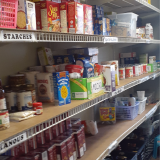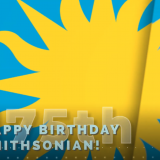S&D Coffee Cuppers, North Carolina
Story Narrative:
What on earth is a cupper? Find out more about the job of cuppers at the S&D Coffee plant in North Carolina by watching this story with Tonya Baptist. Click on the link to learn the history of S&D Coffee in the Cabarrus County Youth Commission's Story Map. Eastern Cabarrus Historical Society, in conjunction with the Mt. Pleasant Public Library, collaborated with the Cabarrus County Youth Commission in the spring of 2018 to create an innovative online exhibition inspired by the "The Way We Worked" for MoMS' Stories: YES program. The Youth Commission is completely student-led and gives teens an opportunity to be active citizens in their community.
Joe: (00:10): We, the Youth Commission are here with Tonya Baptist, one of S&D's best cuppers. So, Miss Tonya, may I ask first and foremost, what is cupping?
Tonya Baptist: (00:22) Cupping is a way of actually looking at the coffee quality on the sensory side. We're looking at a lot of the element compounds of the coffee and we actually test them both with consistency of each blend of coffee that we produce. When we get coffee in it is inherent that you're going to have foreign objects, foreign debris. Our job is to weed out some of those hot spots, things that are obvious that would stand out, any red flags, can try to remove that. That's our job before it even gets to that finished package. In the common past they've associated the coffee of the Indian meal moth although it's not actually attracted to the coffee. So it's more attracted to the burlap bag that the coffee is transported in. We have an actual certified company that helps with pest control for S&D. They're Contracting by the company to come in a set traps occasionally. They bond with nests so we make sure our sanitation record as well as auditing and treatment is up to par. Because we are the finishers we put that coffees through a lot of physical attribute testing. We also not only running tests on the finished product, we are validating the equipment to run or not running. It's on the job training. I'm still learning.
Tonya Baptist: (01:44) It's 10 years later. There's a little more than a hundred certified Q graders in the United States. People that actually cut to the utmost levels of the abilities in coffee. You have to pass 23 sensory exams and it's not just coffee. They test you on black coffee and add all types of different organic acids to what you have to identify the acids and the intensity to taste you on salt, sweet sour, bitter, they test you on coffee theory. They test you on proper handling and processing property. I would say this is my fourth year being certified. One of those hundred people that are Q grader certified.
Joe: (02:28) Would you be able to show us the cupping process?
Tonya Baptist: (02:34) Yeah, Joe and I will. We want to have rhyme and reason for a few that we do. There's 8.2 grams of brown product in each of the glasses and we always test, at minimum, in duplicate. We want to do that because we want to use good laboratory practice. The whole fact of science, right, doing a proper scientific experiment. After we put 8.2 grams in each glass we pour near boiling water over the grounds, we allow the coffee to stick for four to five minutes and that's following the SCAA cupping protocol. A lot of people ask why don't we have the red lights well they're present to try to help remove any biases that one might take for looking at coffees visual. We don't want any biases. We won't truly be objectionable and consistent with how we cup the coffee.
So we want a cupper at the table for the team because I may have a cold today, I may have a favorite, Joe May have had a pastrami sandwich with extra pickles for lunch. So we want to make sure that we have good uniform evaluation of coffee. And what he's doing now is he's getting as close as he can to the cups, almost like a nose tip to the cups and he's breaking this top layer. What's up under that layer are volatiles and vapors and when cup it's very hot it gives you an explosion in the room. That explosion of aroma really gives you a great idea of what the cup is going to taste like.
Tonya Baptist (3:58) So coffee cupping is very much based on what you taste and what you smell. They work together. So this frothy layer that is produced is called the crema. Now I'll go ahead and I'll start removing the crown. Skimming and that's what that step is called. You'll see the coffee spoon is different than your average spoon at home. The ladle is flatter, large. And the whole idea is I don't want to dip half the cup just removing the crema. I want to be selective and only get the foam. Much like wine tasting we actually want to aerate in coffee. What does that mean? We want to mix the coffee with air as much as we possibly can. So I dipped from the back of the spoon and then I'm going to sip from the front. You want to be cognizant of the next person. So if I back it in my mouth never touches the liquid that's in the cup.
Joe: (02:34) What tastes would you be looking for?
Tonya Baptist: (05:05) It depends on the blend. Every single one of these are different blends. So but this one in particular that is a McDonald's smooth coffee. That's a coffee that is proprietary to that particular blend so in the back of my mind intuitively I know what I need to taste for that particular coffee. And the other part of it is any red flag any [inaudible 00:00:05:26]. If it's slightly dirty, if it's hugely dirty, if it's hard, it just musty, if it's fermented. And you don't want to consume that much coffee every time you cup. Which makes sense to get out, spit it out.
Joe: (05:37) And at the end of the day we'll cup maybe 800 cups of coffee. So a sip out of 800 cups of coffee by the time as Tonya said by the time 5 o'clock rolls around you may not be able to find your car.
Tonya Baptist: (05:55) It's a great opportunity to be able to taste same of the best coffees in the world [inaudible 00:05:58] You deeply appreciate the amount of work and energy and allocations. We talk about commodity the buying and trading market. I mean, there's a lot that goes into a cup of coffee that I never knew existed.
Asset ID: 2018.15
Themes: Industry, business, work, food, agriculture, doffee
Date recorded: 2018
Length of recording: 6:17 m
Related traveling exhibition: The Way We Worked
Sponsor or affiliated organization: Eastern Cabarrus Historical Society; Mt. Pleasant Public Library, North Carolina
More information: https://museumonmainstreet.org/blog-node/youth-commission-digs-deep-storytelling-north-carolina



